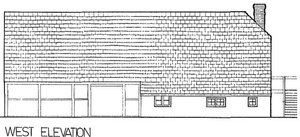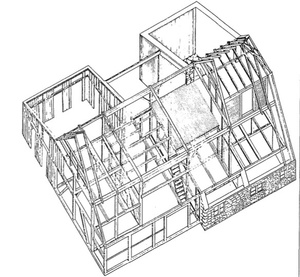This Page forms part of the overall Zebra-ProjectBy clicking on the following Link a list of all Zebra-Project tabbed pages will be displayed. |
Lothar BRASSE
Mooney's Barn |
To return to: Liebelt-Faehrmann. To return to: Lothar BRASSE summary. To return to: Paechtown house 1. To return to: Paechtown house 2. To return to: Paechtown house 3. To return to: Paechtown house 4
Summary
The family names mentioned in this article
 Hahndorf Survey Volume 1 page 190. 'Mooney's Barn c1900'
Hahndorf Survey Volume 1 page 190. 'Mooney's Barn c1900'
 Hahndorf Survey Volume 1 page 191
Hahndorf Survey Volume 1 page 191 


 Hahndorf Survey Volume 1 page 192
Hahndorf Survey Volume 1 page 192 


 Hahndorf Survey Volume 1 page 193
Hahndorf Survey Volume 1 page 193 
Hahndorf Survey Volume 1 page 110
Aim of Article
Table of Contents
1. Author's Note
2.
3.
Photographs by John JENNINGS
Flickr. July 2017
"Mooney Barnhaus', & 'farmhouse, barn, shed & slab outbuilding' Windsor Avenue car Windsor & Schroeder Ave, Hahndorf, S.A.
Mooney’s Barn has similar characteristics to barnhouses found in central and northern Europe. This land was acquired by CFE Reimann in 1854. The large roof is believed to cover the original two room living accommodation, the hay and grain storage, and implement area. Later a lean-to dairy was added. This is a significant barn with complex structure and history.
The ancient Saxon tradition whereby man, his animals and goods were all housed under one roof, common even in twentieth century Mecklenburg, is a rare house-form in South Australia. Only one such building, Mooney's Barn, near Hahndorf, has been discovered, although others are said to have existed. Two further barns at Paechtown have similar structure. One has been renovated into current living accommodation.
Farmhouse: walls constructed of local stone with [rendered] red-brick dressings, hipped corrugated galvanised iron roof, timber-framed openings with timber doors & timber-framed double-hung sash windows, red-brick chimneys with coursing to top, and corrugated galvanised iron bull-nose verandah with timber posts. Barn & shed: timber frames including saplings & branches, cgi cladding and gable roofs. Timber-slab shed: timber frame, timber-slab cladding and corrugated galvanised iron skillion roof."
Source:https://localwiki.org/adelaide-hills/Hahndorf_Old_Barns
https://maps.sa.gov.au/heritagesearch/HeritageItem.aspx?p_heritageno=18390

 Locations SA MapViewer.https://location.sa.gov.au/viewer/?map=hybrid&x=138.8376642&y=-35.02687088&z=18&uids=95,102,180
Locations SA MapViewer.https://location.sa.gov.au/viewer/?map=hybrid&x=138.8376642&y=-35.02687088&z=18&uids=95,102,180
1. Authors Note
Hahndorf Survey Volume 1 page 189
"This is the only building in the Hahndorf district discovered so far which has similar characteristics to the barnhouses commonly found in many parts of north and central Europe. The property lies approximately 3 kms. east of Hahndorf in the Hundred of Onkaparinga. The present owner's family acquired the farm from the family of Carl Friedrich Edward REIMANN in 1895. The latter had originally acquired the land in 1854 and the house was probably built not long. after this date. The large roof covers living quarters, a dairy, the stables, an implement and buggy shed, chaff room and hay loft. It has an unbelievably complicated structure with the original timber framing interlocking at the end of the building into a stone built structure. This suggests a completely framed barn house was built at first with very simple two-roomed living accommodation combined with a cart shed and hayloft.
Whether horses were ever stabled in it is difficult to decide. The thickness of the upper timber floors and the sturdy beams strongly braced to ground floor posts does suggest however that grain may have been stored at this level as well as hay. Eventually a half-timber framed lean-to dairy was added and an adjoining porch which also gave access to a new stone built kitchen, living room and a large bedroom [formed out of the previous timber framed quarters]. Apart from a separate ground level room which could have been a bedroom or workroom an upstairs bedroom was built to which access was obtained from an external staircase and landing. The en-suite arrangement of the bedrooms and the imported hardware all point to a European rather than Anglo Saxon tradition. A very sophisticated timber framing has been employed in this building, similar in many ways to the timber barns described hereafter. The roof and upper floor frames are supported on braced cross beams carried onto timber columns, at irregular spacings. This was to allow for the parking of carts and buggies in part of the stables. Although this building is in a dilapidated state it deserves careful restoration and consideration as to its viable future use."





